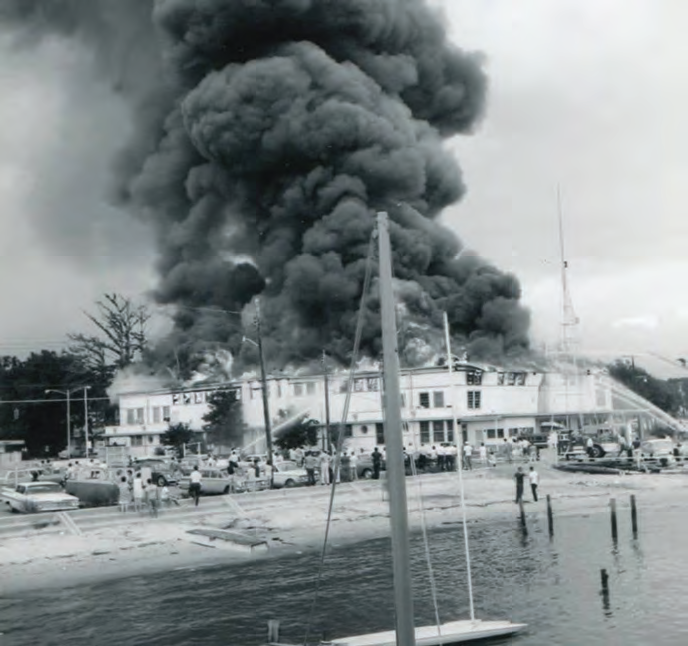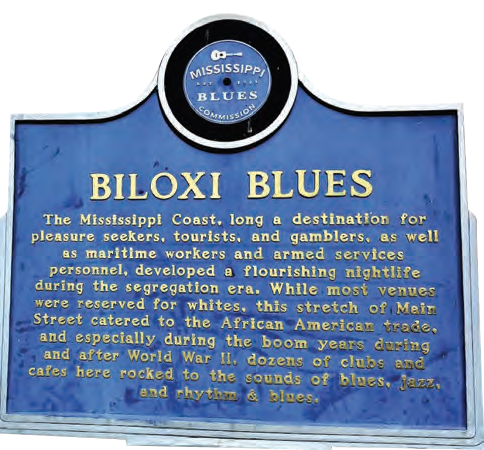Biloxi's Perseverance Through Three Historic Fires
Posted by Paige Gutierrez on Nov 2nd 2023
This article originally written by Paige Gutierrez with the title "Three Fires". Paige is a local Biloxi writer for BNews Monthly, the monthly newsletter of the City of Biloxi. Photographs courtesy of the LHG Image Collection / Local History & Genealogy Department / Harrison County Library System unless otherwise specified.
PHOTO — Biloxi’s multipurpose USO building was dedicated in March 1942 “for wartime use as a recreation center for members of the armed forces.” Its auditorium had a seating capacity of 3,000, and the dance floor was said to be the largest in Mississippi. The building was serving as Biloxi’s Community Center when it burned in 1966. Source: The Daily Herald, Keesler News. Photo by Army Air Force Technical Training Command.
Biloxi Community Center, 1966
 On August 20, 1966, The Daily Herald reported that “The Biloxi Community Center, a large wood frame building which served many years as the USO Center, was destroyed by fire Friday afternoon. The loss was estimated at $160,000. Fire broke out in the southeast corner of the building on the south side of Highway 90 at Main Street about 4 p.m., and within a short while, the entire roof had collapsed.
On August 20, 1966, The Daily Herald reported that “The Biloxi Community Center, a large wood frame building which served many years as the USO Center, was destroyed by fire Friday afternoon. The loss was estimated at $160,000. Fire broke out in the southeast corner of the building on the south side of Highway 90 at Main Street about 4 p.m., and within a short while, the entire roof had collapsed.
All units from the Biloxi fire department, along with units from Pascagoula, Ocean Springs, d’Iberville, Gulfport and Keesler AFB, were able to do little to control the blaze which roared through the structure… flames reached as high as 50 feet and a cloud of black smoke trailed across the city over the Bay of Biloxi, blown by a south wind. ‘We had five lines on the front of the building at one time and it didn’t faze the fire,’ said Bn. Chief Vearl Parker, one of the firemen in charge.”
The large building burned down in about an hour and a half. Among items lost in the fire were uniforms for Colt and Pony League baseball teams and Peewee football teams, as well as musical instruments owned by The Outrage, a teen-age band scheduled to play for a dance at the community center that evening. Firefighters worked into the night to prevent the fire’s spread to nearby buildings and the many cypress trees near the site. Source: The Daily Herald.
PHOTO — On late Friday afternoon August 19, 1966, the Biloxi Community Center, formerly the USO building, was destroyed in an intense fire. Photo likely taken from Biloxi Yacht Club. Source: The Daily Herald.
Buck Theatre, Mardi Gras Night Parade, 1966
 On February 23, 1966, The Daily Herald reported on the prior evening’s unexpected Mardi Gras drama: “The Buck Theatre was gutted by flames Tuesday night in Biloxi in a fire that broke out as the Mardi Gras parade was passing. Two other buildings were destroyed in the fire which was fought by units from four Coast cities and Keesler Air Force Base in addition to the Biloxi equipment. The blaze broke out during the height of the gala night parade, climax of the day of merriment.” The Queen’s float had already passed the Buck Theatre at the corner of Lameuse and Jackson Streets when the fire was reported at 8:50 p.m. The two units immediately behind the Queen’s float – the Sacred Heart Girls High School band and the Duke’s float – were sent east on Jackson Street as firefighters cleared Lameuse Street. Other parade units were turned west at a safer distance from the fire, on Water Street. After the blaze was brought under control, firemen and civilians worked through the night fighting hotspots. By Ash Wednesday morning, the fire was out. Source: The Daily Herald.
On February 23, 1966, The Daily Herald reported on the prior evening’s unexpected Mardi Gras drama: “The Buck Theatre was gutted by flames Tuesday night in Biloxi in a fire that broke out as the Mardi Gras parade was passing. Two other buildings were destroyed in the fire which was fought by units from four Coast cities and Keesler Air Force Base in addition to the Biloxi equipment. The blaze broke out during the height of the gala night parade, climax of the day of merriment.” The Queen’s float had already passed the Buck Theatre at the corner of Lameuse and Jackson Streets when the fire was reported at 8:50 p.m. The two units immediately behind the Queen’s float – the Sacred Heart Girls High School band and the Duke’s float – were sent east on Jackson Street as firefighters cleared Lameuse Street. Other parade units were turned west at a safer distance from the fire, on Water Street. After the blaze was brought under control, firemen and civilians worked through the night fighting hotspots. By Ash Wednesday morning, the fire was out. Source: The Daily Herald.
PHOTO — Buck Theatre on fire, Mardi Gras night, 1966. Photo: The Daily Herald.
Accomo Hotel and Restaurant, 1972
 A Mississippi Blues Trail marker for Biloxi’s central Main Street reads as follows: “The Mississippi Coast, long a destination for pleasure seekers, tourists, and gamblers, as well as maritime workers and armed services personnel, developed a flourishing nightlife during the segregation era. While most venues were reserved for whites, this stretch of Main Street catered to the African American trade, and especially during the boom years during and after World War II, dozens of clubs and cafes here rocked to the sounds of blues, jazz, and rhythm & blues.”
A Mississippi Blues Trail marker for Biloxi’s central Main Street reads as follows: “The Mississippi Coast, long a destination for pleasure seekers, tourists, and gamblers, as well as maritime workers and armed services personnel, developed a flourishing nightlife during the segregation era. While most venues were reserved for whites, this stretch of Main Street catered to the African American trade, and especially during the boom years during and after World War II, dozens of clubs and cafes here rocked to the sounds of blues, jazz, and rhythm & blues.”
A part of this history was lost in a fire on November 22, 1972. The Daily Herald reported that “Biloxi’s oldest Negro hotel, the Accomo Hotel and Restaurant, was gutted by an early morning fire today. The hotel, located at 744 Main St. and a mecca for some of the nation’s foremost Negro bands during and immediately following World War II, was gutted and virtually destroyed within 45 minutes after the fire had broken out. The hotel was originally a nightclub, known as the Paradise Gardens. Later, it was converted into a rooming house and finally into a hotel.” Famous entertainers who appeared at the hotel included blues, rhythm & blues, and rock & roll greats Fats Domino, Guitar Slim, Chuck Willis, Johnny Otis and others. The fire was attributed to a faulty space heater. Source: The Daily Herald.
PHOTO — Mississippi Blues Commission’s Blues Trail historic marker for Main Street, Biloxi.
###
Hungry for shrimp? Visit our Shop page to order wild-caught Gulf shrimp to be shipped to anywhere in the country today!

